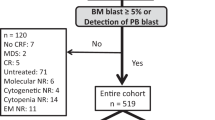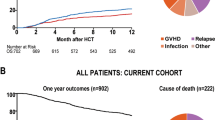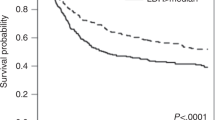Abstract
Predicting severe acute GvHD (aGvHD) after allogeneic hematopoietic stem cell transplantation (HSCT) is challenging but critical. Mild aGvHD may have a favorable impact on relapse, whereas severe aGvHD is associated with poor outcomes. The aim of this study was to evaluate whether elevated eosinophil count in the bone marrow (BM) at 1 month after HSCT is associated with a high incidence of new and severe aGvHD. We enrolled 101 consecutive patients; median age was 50 years, and 50.5% patients were male. The median eosinophil concentration in BM at 1 month after HSCT was 1.1% (quartile 0.4–2.2%). The adjusted hazards ratio at 95% confidence interval for severe aGvHD was 1.26 (1.12–1.42, P<0.001), per 1% increase in eosinophil concentration, and 3.76 (1.41–10.05, P=0.008) for the high-risk group at a cutoff value of 4.0%. In addition, the predictive accuracy described by area under the curve of receiver operating characteristics, increased from 0.784 to 0.866 (P=0.033) with the increasing concentration of eosinophils. In conclusion, elevated concentration of eosinophils in BM was associated with high incidence and predictive accuracy of severe aGvHD. BM eosinophil concentration can be one of the key markers to predict aGvHD.
This is a preview of subscription content, access via your institution
Access options
Subscribe to this journal
Receive 12 print issues and online access
$259.00 per year
only $21.58 per issue
Buy this article
- Purchase on Springer Link
- Instant access to full article PDF
Prices may be subject to local taxes which are calculated during checkout




Similar content being viewed by others
References
Thomas ED, Storb R, Clift RA, Fefer A, Johnson L, Neiman PE et al. Bone-marrow transplantation (second of two parts). N Engl J Med 1975; 292: 895–902.
Rowlings PA, Przepiorka D, Klein JP, Gale RP, Passweg JR, Henslee-Downey PJ et al. IBMTR severity Index for grading acute graft-versus-host disease: retrospective comparison with Glucksberg grade. Br J Haematol 1997; 97: 855–864.
Bacigalupo A, Van Lint MT, Occhini D, Gualandi F, Lamparelli T, Sogno G et al. Increased risk of leukemia relapse with high-dose cyclosporine A after allogeneic marrow transplantation for acute leukemia. Blood 1991; 77: 1423–1428.
Locatelli F, Zecca M, Rondelli R, Bonetti F, Dini G, Prete A et al. Graft versus host disease prophylaxis with low-dose cyclosporine-A reduces the risk of relapse in children with acute leukemia given HLA-identical sibling bone marrow transplantation: results of a randomized trial. Blood 2000; 95: 1572–1579.
Baron F, Labopin M, Niederwieser D, Vigouroux S, Cornelissen JJ, Malm C et al. Impact of graft-versus-host disease after reduced-intensity conditioning allogeneic stem cell transplantation for acute myeloid leukemia: a report from the Acute Leukemia Working Party of the European group for blood and marrow transplantation. Leukemia 2012; 26: 2462–2468.
Malard F, Szydlo RM, Brissot E, Chevallier P, Guillaume T, Delaunay J et al. Impact of cyclosporine-A concentration on the incidence of severe acute graft-versus-host disease after allogeneic stem cell transplantation. Biol Blood Marrow Transplant 2010; 16: 28–34.
Mori T, Kato J, Shimizu T, Aisa Y, Nakazato T, Yamane A et al. Effect of early posttransplantation tacrolimus concentration on the development of acute graft-versus-host disease after allogeneic hematopoietic stem cell transplantation from unrelated donors. Biol Blood Marrow Transplant 2012; 18: 229–234.
Rogosheske JR, Fargen AD, DeFor TE, Warlick E, Arora M, Blazar BR et al. Higher therapeutic CsA levels early post transplantation reduce risk of acute GvHD and improves survival. Bone Marrow Transplant 2014; 49: 122–125.
Ponce DM, Hilden P, Mumaw C, Devlin SM, Lubin M, Giralt S et al. High day 28 ST2 levels predict for acute graft-versus-host disease and transplant-related mortality after cord blood transplantation. Blood 2015; 125: 199–205.
Chen YB, McDonough S, Hasserjian R, Chen H, Coughlin E, Illiano C et al. Expression of CD30 in patients with acute graft-versus-host disease. Blood 2012; 120: 691–696.
Xiao B, Wang Y, Li W, Baker M, Guo J, Corbet K et al. Plasma microRNA signature as a noninvasive biomarker for acute graft-versus-host disease. Blood 2013; 122: 3365–3375.
Nonomura A, Kono N, Mizukami Y, Nakanuma Y . Histological changes of the liver in experimental graft-versus-host disease across minor histocompatibility barriers. VIII. Role of eosinophil infiltration. Liver 1996; 16: 42–47.
Daneshpouy M, Socie G, Lemann M, Rivet J, Gluckman E, Janin A . Activated eosinophils in upper gastrointestinal tract of patients with graft-versus-host disease. Blood 2002; 99: 3033–3040.
Janin A, Ertault-Daneshpouy M, Socie G . Eosinophils and severe forms of graft-versus-host disease. Blood 2003; 101: 2073.
Sato T, Kobayashi R, Nakajima M, Iguchi A, Ariga T . Significance of eosinophilia after stem cell transplantation as a possible prognostic marker for favorable outcome. Bone Marrow Transplant 2005; 36: 985–991.
Aisa Y, Mori T, Nakazato T, Shimizu T, Yamazaki R, Ikeda Y et al. Blood eosinophilia as a marker of favorable outcome after allogeneic stem cell transplantation. Transpl Int 2007; 20: 761–770.
Imahashi N, Miyamura K, Seto A, Watanabe K, Yanagisawa M, Nishiwaki S et al. Eosinophilia predicts better overall survival after acute graft-versus-host-disease. Bone Marrow Transplant 2010; 45: 371–377.
Weaver J, Bergfeld WF . Quantitative analysis of eosinophils in acute graft-versus-host disease compared with drug hypersensitivity reactions. Am J Dermatopathol 2010; 32: 31–34.
Basara N, Kiehl MG, Fauser AA . Eosinophilia indicates the evolution to acute graft-versus-host disease. Blood 2002; 100: 3055.
Giralt S, Ballen K, Rizzo D, Bacigalupo A, Horowitz M, Pasquini M et al. Reduced-intensity conditioning regimen workshop: defining the dose spectrum. Report of a workshop convened by the center for international blood and marrow transplant research. Biol Blood Marrow Transplant 2009; 15: 367–369.
Bacigalupo A, Ballen K, Rizzo D, Giralt S, Lazarus H, Ho V et al. Defining the intensity of conditioning regimens: working definitions. Biol Blood Marrow Transplant 2009; 15: 1628–1633.
Hamadani M, Mohty M, Kharfan-Dabaja MA . Reduced-intensity conditioning allogeneic hematopoietic cell transplantation in adults with acute myeloid leukemia. Cancer Control 2011; 18: 237–245.
Fonarow GC, Adams KF Jr, Abraham WT, Yancy CW, Boscardin WJ et alAdhere Scientific Advisory Committee SG. Risk stratification for in-hospital mortality in acutely decompensated heart failure: classification and regression tree analysis. JAMA 2005; 293: 572–580.
Beier F, Arbter K, Kittan NA, Andreesen R, Krause SW, Holler E et al. Regression of eosinophil counts after diagnosis of chronic graft-versus-host disease as a potential marker for improved clinical outcome. Mol Clin Oncol 2014; 2: 81–86.
Cromvik J, Johnsson M, Vaht K, Johansson JE, Wennerås C . Eosinophils in the blood of hematopoietic stem cell transplanted patients are activated and have different molecular marker profiles in acute and chronic graft-versus-host disease. Immun Inflamm Dis 2014; 2: 99–113.
Hallgren R, Colombel JF, Dahl R, Fredens K, Kruse A, Jacobsen NO et al. Neutrophil and eosinophil involvement of the small bowel in patients with celiac disease and Crohn's disease: studies on the secretion rate and immunohistochemical localization of granulocyte granule constituents. Am J Med 1989; 86: 56–64.
Hällgren R, Bohman SO, Fredens K . Activated eosinophil infiltration and deposits of eosinophil cationic protein in renal allograft rejection. Nephron 1991; 59: 266–270.
de Groen PC, Kephart GM, Gleich GJ, Ludwig J . The eosinophil as an effector cell of the immune response during hepatic allograft rejection. Hepatology 1994; 20: 654–662.
Imoto S, Oomoto Y, Murata K, Das H, Murayama T, Kajimoto K et al. Kinetics of serum cytokines after allogeneic bone marrow transplantation: interleukin-5 as a potential marker of acute graft-versus-host disease. Int J Hematol 2000; 72: 92–97.
Fujii N, Hiraki A, Aoe K, Murakami T, Ikeda K, Masuda K et al. Serum cytokine concentrations and acute graft-versus-host disease after allogeneic peripheral blood stem cell transplantation: concurrent measurement of ten cytokines and their respective ratios using cytometric bead array. Int J Mol Med 2006; 17: 881–885.
Dent LA, Strath M, Mellor AL, Sanderson CJ . Eosinophilia in transgenic mice expressing interleukin 5. J Exp Med 1990; 172: 1425–1431.
Acknowledgements
We thank the medical and nursing staff working at our institution, and would like to express our gratitude to the Japan Society of Clinical Research (http://www.japanscr.org/) for their dedicated support.
Author information
Authors and Affiliations
Corresponding author
Ethics declarations
Competing interests
The authors declare no conflict of interest.
Rights and permissions
About this article
Cite this article
Shimomura, Y., Hara, M., Hashimoto, H. et al. Elevated bone marrow eosinophil count is associated with high incidence of severe acute GvHD after allogeneic hematopoietic stem cell transplantation. Bone Marrow Transplant 52, 1311–1316 (2017). https://doi.org/10.1038/bmt.2017.98
Received:
Revised:
Accepted:
Published:
Issue Date:
DOI: https://doi.org/10.1038/bmt.2017.98



